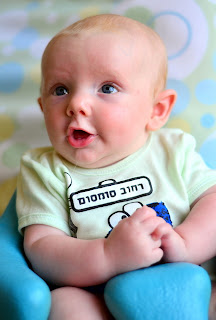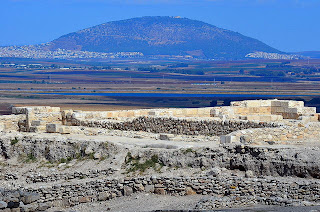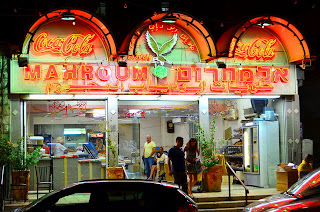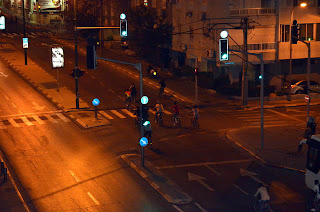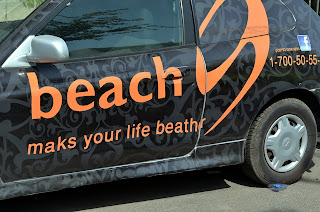Rockets weren't the only story this week--there was also apparently a thwarted stabbing by a Palestinian woman who had waited until after the release of Gilad Shalit (I blogged about the lopsided 1027 for 1 prisoner exchange last week - you can read it here, if interested) to make her attempt.
We're learning that these types of things are just part of life here in Israel. I brought up the recent rockets in conversation at the lunch table yesterday only to have my co-workers shrug it off. Nothing new, certainly. As part of this conversation, I learned that our cafeteria (on the first floor of the parking garage) is reinforced as a shelter against attacks--as are the centrally located conference rooms and the stairwells. Even residential homes have reinforced rooms in which families can take shelter when the warning sirens are active. My talkative cubemate is in the process of building a new home, and complained about the new construction code requiring him to install an (expensive) air filtration system in his home's "protected area" which would, in theory, help protect his loved ones against chemical warfare.
And now, time to catch up a bit. A few weeks ago during the long holiday weekend for Rosh Hashana, we visited Jerusalem (details here) and then Caesarea National Park. Caesarea Maratima was a city and harbor brought to prominence by Harod "the Great" 25 or so years BC. Today, some of the ruins can be seen by visitors like us.
Caesarea National Park is located just 40 minutes or so north of Tel Aviv. 40 minutes without traffic, that is. After cruising along northbound on the 4-lane Israeli highway 2, traffic came to a screetching halt due to an accident up ahead. And, in a China-esque moment, people actually began driving in REVERSE in order to reach an already-passed exit ramp in order to avoid the mayem. We stayed the course, however, and arrived in Ceasarea about 30 minutes behind schedule.
Named to honor the Caesar, Caesarea became the seat of the Roman prefect and grew to a size of approximately 125,000 people--including Pontius Pilate, who resided there. The city boasted a large man-made harbor which included a 400m breakwater, a theatre which could (and still can) accommodate 4000 spectators, and a "hippodrome" in which 30,000 fans could cheer on their favorite chariots during races.
Here's a picture of some of the ruins at Caesarea National Park.
Here is a Bosian Mosque at Caesarea (built much later than Harod's day).
Here is a sign noting the Apostle Paul's appeal to Caesar, which took place in Caesarea as documentated in Acts 25.
And here is the view that Paul may have had while making his case to Festus. Paul spent two years in prison here in Caesarea before sailing to Rome to eventually have his case heard by Caesar.
According to one of the two maps we were given at the national park, this is the chariot-race enabling hippodrome. According to the second map, this was the Herodean Ampitheater. And if the second map is correct, we missed the actual hippodrome.
And here are some ruins near the bathouse of Caesarea.
Some other Bibilcal references to Caesarea include but are not limited to: Philip the evangelist preaching there (Acts 8:40) and Herod Agrippa dying in Caesarea and then being "eaten by worms" (Acts 12:20-23).
One problem with the city's location was that there was no fresh water source nearby. To remedy this, the Romans built an aqueduct to channel water in from a spring 7.5km away. The aqueduct was quite an engineering feat--maintaining a grade of 20cm per 1km, which required it to be elevated by stone archways in low-lying areas. We didn't see the aqeduct first-hand since it was outisde of the park and Sammy wasn't in the mood for additional sight-seeing, but if you're interested in seeing what it looks like, click here.
While our quick trip to Casarea was interesting and eye-opening, we spent much of the afternoon trying to keep our little Sammy happy. He was having a bit of a fussy day.
And here is little Sam on his bumbo while sporting his first clothing purchase here in Israel. The shirt says, in Hebrew "Rehov Soomsoom" (or sohmsohm--I have trouble discerning the vowels), which apparently means Sesame Street.
And now back to the present. We are currently watching a ridiculously entertaining Game 6 of the World Series on a 17 hour time delay. So far, we've avoided facebook and most websites (except blogger, of course) in order to not spoil the outcome. But, we did spot a game 7 on the TV guide for 1:30am tomorrow, and saw a snippet on the news about a historic 11-inning game, so we are hoping that this means the Cardinals must've pulled it out. Assuming a win, we've got to make a decision about whether to stay up and watch game 7 live, or to watch tomorrow evening with a delay.
Oh and one interesting tidbit from this afternoon... Nicki had met a neighbor of ours the other day and ended up having quite an extended conversation with her. This afternoon, while walking back from the beach we spotted this neighbor in passing on the sidewalk. She greeted Nicki and introduced herself to me, but didn't have time to chat. As she hurried away, Nicki and I compared notes on what she'd uttered, and agreed that she'd said something about being a shabbat keeper and lighting candles. With a quick google search after we reached our apartment, we realized that she was racing home to light her shabbat candles, which must be lit 18 minutes prior to sunset on Friday.
And speaking of sunsets, below is a time lapse video from tonight's (early) sunset here in Tel Aviv. I say early because the sun currently sets around 5pm due to the fact that Israel executes daylight savings time earlier than the rest of the world. We've learned that this is a rule enacted by the ultra-religous minority to encourage more Jews to participate in the Yom Kippur fast. This year's Yom Kippur was particularly early in the Gregorian calendar, which caused some tension between and in a petition to change the rules.
Here is a quote from a story regarding the daylight savings controversy:
"Never mind that you think it's still hot. In two weeks, winter will arrive," Strasler wrote. "In that, Israel is unique. Only here can a minority community of observant Jews bend the will of the majority and turn the height of summer into winter, at least officially. The sun refuses to obey."
If that piqued your interest, see here for the full story, and here for our experience on Yom Kippur in case you missed it.
Ok, back to that sunset. Nothing spectacular, but it is always amazing to watch and tonight was fun to capture. My new Nikon D5100 has an intervalometer, so I set it up to take a picture every 7 seconds and then put the 120 or so pictures together in Windows Movie Maker.
And lastly, below are some additional pictures of the ruins of Caesarea if you're interested.







